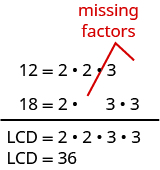Adding and Subtracting Fractions With Different Denominators
Learning Outcomes
- Add or subtract fractions with different denominators
- Add or subtract fractions that contain variables and have different denominators
Once we have converted two fractions to equivalent forms with common denominators, we can add or subtract them by adding or subtracting the numerators.
Add or subtract fractions with different denominators
- Find the LCD.
- Convert each fraction to an equivalent form with the LCD as the denominator.
- Add or subtract the fractions.
- Write the result in simplified form.
Example
Add: [latex]\frac{1}{2}+\frac{1}{3}[/latex] Solution:| [latex]\frac{1}{2}+\frac{1}{3}[/latex] | |
Find the LCD of [latex]2[/latex], [latex]3[/latex].
 |
|
| Change into equivalent fractions with the LCD [latex]6[/latex]. | [latex]\frac{1\cdot\color{red}{3}}{2\cdot\color{red}{3}} + \frac{1\cdot\color{red}{2}}{3\cdot\color{red}{2}}[/latex] |
| Simplify the numerators and denominators. | [latex]\frac{3}{6}+\frac{2}{6}[/latex] |
| Add. | [latex]\frac{5}{6}[/latex] |
Try It
#146262 [ohm_question height="230"]146262[/ohm_question]Example
Subtract: [latex]\frac{1}{2}-\left(-\frac{1}{4}\right)[/latex]Answer: Solution:
| [latex]\frac{1}{2}-\left(-\frac{1}{4}\right)[/latex] | |
Find the LCD of [latex]2[/latex] and [latex]4[/latex].
 |
|
| Rewrite as equivalent fractions using the LCD [latex]4[/latex]. | [latex]\frac{1\cdot\color{red}{2}}{2\cdot\color{red}{2}} - (--\frac{1}{4})[/latex] |
| Simplify the first fraction. | [latex]\frac{2}{4}-\left(-\frac{1}{4}\right)[/latex] |
| Subtract. | [latex]\frac{2-\left(-1\right)}{4}[/latex] |
| Simplify. | [latex]\frac{3}{4}[/latex] |
Try It
#146264 [ohm_question height="230"]146264[/ohm_question]Example
Add: [latex]\frac{7}{12}+\frac{5}{18}[/latex]Answer: Solution:
| [latex]\frac{7}{12}+\frac{5}{18}[/latex] | |
Find the LCD of [latex]12[/latex] and [latex]18[/latex].
 |
|
| Rewrite as equivalent fractions with the LCD. | [latex]\frac{7\cdot\color{red}{3}}{12\cdot\color{red}{3}} + \frac{5\cdot\color{red}{2}}{18\cdot\color{red}{2}}[/latex] |
| Simplify the numerators and denominators. | [latex]\frac{21}{36}+\frac{10}{36}[/latex] |
| Add. | [latex]\frac{31}{36}[/latex] |
Try It
#146265 [ohm_question height="230"]146265[/ohm_question] The LCD, [latex]36[/latex], has [latex]2[/latex] factors of [latex]2[/latex] and [latex]2[/latex] factors of [latex]3[/latex].
Twelve has two factors of [latex]2[/latex], but only one of [latex]3[/latex] —so it is ‘missing‘ one [latex]3[/latex]. We multiplied the numerator and denominator of [latex]\frac{7}{12}[/latex] by [latex]3[/latex] to get an equivalent fraction with denominator [latex]36[/latex].
Eighteen is missing one factor of [latex]2[/latex] —so you multiply the numerator and denominator [latex]\frac{5}{18}[/latex] by [latex]2[/latex] to get an equivalent fraction with denominator [latex]36[/latex]. We will apply this method as we subtract the fractions in the next example.
The LCD, [latex]36[/latex], has [latex]2[/latex] factors of [latex]2[/latex] and [latex]2[/latex] factors of [latex]3[/latex].
Twelve has two factors of [latex]2[/latex], but only one of [latex]3[/latex] —so it is ‘missing‘ one [latex]3[/latex]. We multiplied the numerator and denominator of [latex]\frac{7}{12}[/latex] by [latex]3[/latex] to get an equivalent fraction with denominator [latex]36[/latex].
Eighteen is missing one factor of [latex]2[/latex] —so you multiply the numerator and denominator [latex]\frac{5}{18}[/latex] by [latex]2[/latex] to get an equivalent fraction with denominator [latex]36[/latex]. We will apply this method as we subtract the fractions in the next example.
Example
Subtract: [latex]\frac{7}{15}-\frac{19}{24}[/latex]Answer: Solution:
| [latex]\frac{7}{15}-\frac{19}{24}[/latex] | |
Find the LCD.
 [latex-display]15[/latex] is 'missing' three factors of [latex]2[/latex-display]
[latex]24[/latex] is 'missing' a factor of [latex]5[/latex]
[latex-display]15[/latex] is 'missing' three factors of [latex]2[/latex-display]
[latex]24[/latex] is 'missing' a factor of [latex]5[/latex] |
|
| Rewrite as equivalent fractions with the LCD. | [latex]\frac{7\cdot\color{red}{8}}{15\cdot\color{red}{8}} - \frac{19\cdot\color{red}{5}}{24\cdot\color{red}{5}}[/latex] |
| Simplify each numerator and denominator. | [latex]\frac{56}{120}-\frac{95}{120}[/latex] |
| Subtract. | [latex]-\frac{39}{120}[/latex] |
| Rewrite showing the common factor of [latex]3[/latex]. | [latex]-\frac{13\cdot 3}{40\cdot 3}[/latex] |
| Remove the common factor to simplify. | [latex]-\frac{13}{40}[/latex] |
Try It
#146266 [ohm_question height="230"]146266[/ohm_question]Example
Add: [latex]-\frac{11}{30}+\frac{23}{42}[/latex]Answer: Solution:
| [latex]-\frac{11}{30}+\frac{23}{42}[/latex] | |
Find the LCD.
 |
|
| Rewrite as equivalent fractions with the LCD. | [latex]-\frac{11\cdot\color{red}{7}}{30\cdot\color{red}{7}} + \frac{23\cdot\color{red}{5}}{42\cdot\color{red}{5}}[/latex] |
| Simplify each numerator and denominator. | [latex]-\frac{77}{210}+\frac{115}{210}[/latex] |
| Add. | [latex]\frac{38}{210}[/latex] |
| Rewrite showing the common factor of [latex]2[/latex]. | [latex]\frac{19\cdot 2}{105\cdot 2}[/latex] |
| Remove the common factor to simplify. | [latex]\frac{19}{105}[/latex] |
Try It
#146267 [ohm_question height="230"]146267[/ohm_question]Example
Add: [latex]\frac{3}{5}+\frac{x}{8}[/latex]Answer: Solution: The fractions have different denominators.
| [latex]\frac{3}{5}+\frac{x}{8}[/latex] | |
Find the LCD.
 |
|
| Rewrite as equivalent fractions with the LCD. | [latex]\frac{3\cdot\color{red}{8}}{5\cdot\color{red}{8}} + \frac{x\cdot\color{red}{5}}{8\cdot\color{red}{5}}[/latex] |
| Simplify the numerators and denominators. | [latex]\frac{24}{40}+\frac{5x}{8}[/latex] |
| Add. | [latex]\frac{24+5x}{40}[/latex] |
Try It
#146268 [ohm_question height="230"]146268[/ohm_question]Licenses & Attributions
CC licensed content, Shared previously
- Ex: Add Fractions with Unlike Denominators (Basic with Model). Authored by: James Sousa (mathispower4u.com). License: CC BY: Attribution.
- Example: Subtract Fractions with Unlike Denominators. Authored by: James Sousa (mathispower4u.com). License: CC BY: Attribution.
- Ex: Add and Subtract Fractions Containing Variables. Authored by: James Sousa (mathispower4u.com). License: CC BY: Attribution.
CC licensed content, Specific attribution
- Prealgebra. Provided by: OpenStax License: CC BY: Attribution. License terms: Download for free at http://cnx.org/contents/[email protected].
